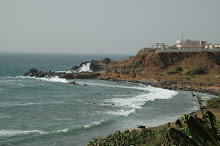 Perhaps you've seen this painting in photos (it hangs in the Louvre), but do you know the story behind it? "The Raft of the Medusa," by Theodore Gericault, depicts an historical event, one of the tragedies of Franco-Senegalese colonial history.
Perhaps you've seen this painting in photos (it hangs in the Louvre), but do you know the story behind it? "The Raft of the Medusa," by Theodore Gericault, depicts an historical event, one of the tragedies of Franco-Senegalese colonial history.In July of 1816, the Medusa, a French frigate, was en route to the capital of French West Africa, St. Louis (san-loo-EE). It carried over 400 people, including the crew. Among its passengers were the new colonial governor and his family.
The captain, who had been granted his position as a political reward, hadn't sailed in 20 years, and was profoundly incompetent. He ran the ship aground on a sandbar some 60 miles off the coast of West Africa, where it broke up.
Lacking sufficient lifeboats, 146 travellers were forced to flee on a makeshift raft tethered to the lifeboats. This arrangement proved ungainly, and the lifeboat's passengers cut the raft loose, abandoning it to the elements.
Thirteen days later, the raft was discovered with only 15 passengers, the rest having died of deyhydration (they had only wine to drink), starvation (despite resorting to cannibalism), or literally raving madness.
The political ramfications of the event were also severe, greatly embarrassing France's post-Napoleonic, newly restored monarchy.
Gericault thoroughly researched his subject, reading first-hand accounts of the tragedy, and even interviewing some of the survivors, one of whom he portrayed in the painting. Begun in 1818, just two years after the incident, and completed in 1819, when the artist was only 28 years old, the painting is considered a seminal work of the Romantic era and perhaps Gericault's masterpiece (he died of tuberculosis just three years later).
The tale is as interesting as it is horrific. It's all the more interesting to me given its geographic and historical connection to my current home. Two recent books on the topic are readily available if you want to pursue the story in more detail.

















